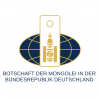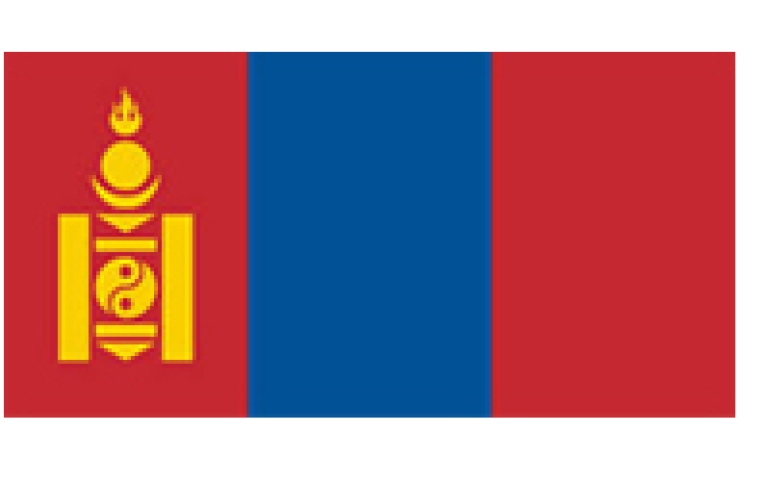Economic overview
Since 1990, Mongolia has successfully transitioned into a market-oriented economy from centrally-planned economy. Today, Mongolia is one of the world’s fastest growing economies.
Gross Domestic Product
In 2011, Mongolia’s GDP grew by 17.5%, compared to a growth rate of 6.4% in 2010. This was mainly because of the favorable performance of both the industry and service sectors due to the increase in foreign direct investment in the mining industry, upward price trends for commodities, such as copper, gold and iron, an increase in export volumes and an increased demand for transportation infrastructure and transportation services driven by the economic development in Mongolia.
The Mongolian economy grew at a slower pace in 2012 but still maintained strong double-digit growth. Annual economic growth decelerated to 12.3 percent in 2012 from 17.5 percent in 2011. Despite slower growth of mineral exports, double-digit economic growth was driven by the robust performance of the non-mineral sector fueled by the recovery of agricultural sector as well as steady growth in construction, transportation and ICT industries.
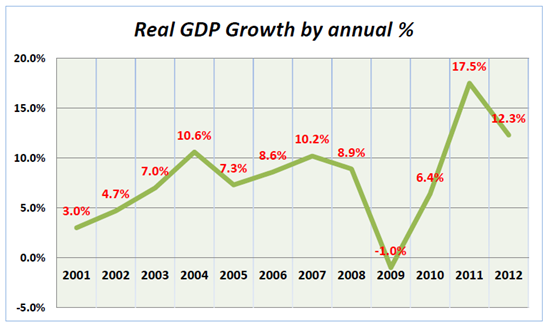
Source: National Statistical Office of Mongolia
Principal Sectors of the Economy
Industry
The industry sector consists of four main sub-sectors: (i) mining and quarrying, (ii) manufacturing, (iii) construction, and (iv) electricity, gas steam and air conditioning supply. In 2011, the industry sector, which accounted for 30.8% of nominal GDP, recorded a growth rate of 9.1%. This growth rate was mainly driven by the growth of the mining andquarrying sub-sector, which recorded a growth rate of 9.1% in 2011.
Agriculture
The agriculture sector consists of agriculture, forestry and fishing and accounted for 12.3% of nominal GDP in 2011. In 2011, the agriculture sector recorded a growth rate of negative 0.5%. This decrease in growth was mainly a result of the continued effect of the severe loss of livestock in late 2009 and early 2010 as a result of extreme winter conditions.
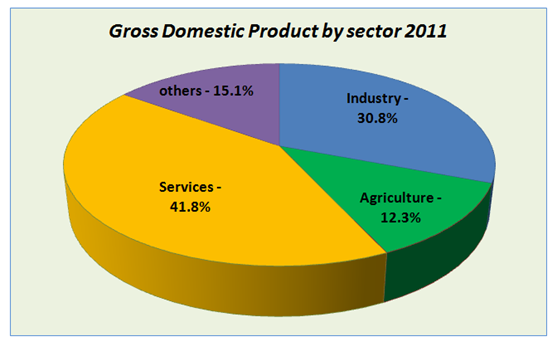
Source: National Statistical Office of Mongolia
Service
The service sector consists of six main sub-sectors: (i) wholesale and retail trade, (ii) transportation and storage, (iii)information and communication, (iv) financial and insurance activities, (v) real estate activities and (vi) education . In 2011, the service sector, which accounted for 41.8% of nominal GDP, recorded a growth rate of 26.8%, compared to 16.7% in 2010. Growth in the service sector in 2011 was attributable to growth in almost all six service sub-sectors, which was primarily driven by the rapidly growing economy.
Foreign trade
In 2012, foreign trade led to a total external trade turnover of U.S.$6.5 billion of which exports represented U.S.$2.5 billion and imports represented U.S.$3.9 billion. In 2012, mineral exports accounted for 89 percent of total exports. The largest exported product was coal, accounting for 43.4 percent, followed by copper concentrate (19.1 percent), crude oil (7.7 percent) and gold (2.8 percent). The three major minerals (copper, coal and goal) together accounted for 73 percent of total exports. In terms of major destination countries of export, China imported 92.6 percent of total exports from Mongolia, followed by Russia (1.8 percent).
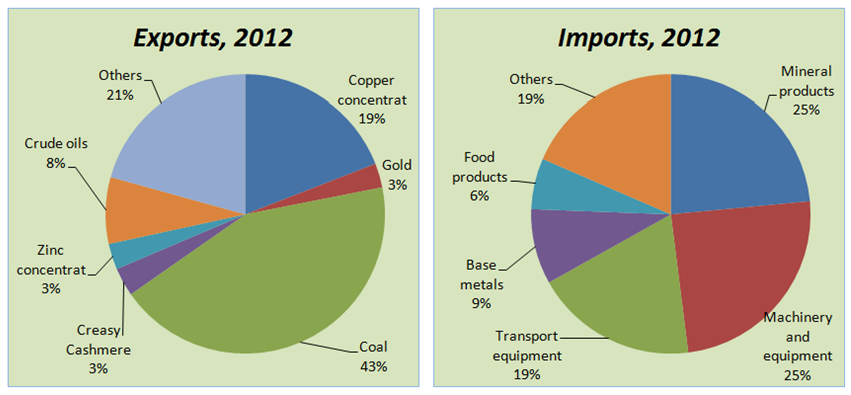
Source: National Statistical Office of Mongolia
The total exports from Mongolia by country /U.S.$ millions/
|
Total exports from Mongolia by country of destination |
For the year ended or as at December 31, |
For the six months ended or as at June 30, | ||||
|
2007 |
2008 |
2009 |
2010 |
2011 |
2012 |
|
| China |
1,411.4 |
1,635.9 |
1,393.9 |
2,466.3 |
4,439.9 |
2,125.5 |
| Canada |
178.6 |
174.6 |
147.5 |
141.6 |
90.8 |
40.1 |
| United States |
99.9 |
114.2 |
13.9 |
6.0 |
5.0 |
2.1 |
| Russia |
58.5 |
86.3 |
68.2 |
82.7 |
96.3 |
33.9 |
| United Kingdom |
22.1 |
165.8 |
126.9 |
67.4 |
20.0 |
3.9 |
| Italy |
56.7 |
42.2 |
31.4 |
31.8 |
49.8 |
9.3 |
| South Korea |
41.5 |
29.9 |
15.5 |
30.5 |
37.9 |
4.9 |
| Germany |
17.8 |
11.0 |
15.6 |
22.1 |
14.9 |
7.7 |
| France |
5.4 |
30.3 |
2.2 |
3.9 |
7.7 |
1.3 |
| Switzerland |
1.8 |
2.1 |
2.8 |
2.9 |
18.0 |
7.3 |
| Japan |
15.1 |
27.6 |
4.6 |
2.7 |
11.0 |
1.7 |
| Others |
38.7 |
214.6 |
62.8 |
50.6 |
26.2 |
24.6 |
| Total |
1,947.5 |
2,534.5 |
1,885.4 |
2,908.5 |
4,817.5 |
2,262.3 |
The total imports of Mongolia by country/U.S.$ millions/
|
Total exports from Mongolia by country of destination |
For the year ended or as at December 31, |
For the six months ended or as at June 30, | ||||
|
2007 |
2008 |
2009 |
2010 |
2011 |
2012 |
|
| Russia |
745.0 |
1,242.3 |
772.8 |
1,046.7 |
1,624.7 |
893.9 |
| China |
568.9 |
898.7 |
538.6 |
971.0 |
2,023.9 |
884.9 |
| United States |
55.7 |
84.1 |
103.7 |
158.9 |
536.0 |
321.0 |
| Japan |
140.2 |
238.5 |
97.0 |
196.5 |
490.2 |
266.7 |
| Korea |
119.6 |
194.8 |
155.1 |
181.8 |
356.7 |
225.9 |
| Germany |
76.5 |
92.6 |
70.3 |
87.2 |
273.6 |
111.0 |
| Canada |
10.6 |
10.8 |
7.5 |
22.3 |
128.3 |
49.1 |
| Belarus |
7.4 |
8.9 |
11.4 |
15.2 |
72.3 |
45.9 |
| Australia |
18.6 |
17.7 |
15.3 |
38.6 |
94.3 |
42.5 |
| Singapore |
29.3 |
45.6 |
27.7 |
51.0 |
69.5 |
38.2 |
| Others |
290.0 |
410.5 |
338.3 |
430.9 |
928.9 |
434.2 |
| Total |
2,061.8 |
3,244.5 |
2,137.7 |
3,200.1 |
6,598.4 |
3,313.3 |
Source: National Statistical Office of Mongolia
Mining in Mongolia
Mongolia is rich in mineral resources and has some of the world’s major mineral deposits including gold, copper,uranium and coal. Geological data gathered since the 1920s and exploration to date has proven vast mineralreserves, but only 15 per cent of the country has been fully mapped. There are over 6,000 deposits of around 80 different minerals discovered to date in Mongolia. Key mining projects are expected to have a positive impact on Mongolia’s overal economic situation as commercial production commences.
|
Minerals |
Estimated reserves/as January 1, 2012/ |
| Coal (million tons) | 18,473.2 |
| Iron (million tons) | 1,046.6 |
| Copper (thousand tons) | 83,807 |
| Lead (thousand tons) | 1,740 |
| Gold (placer) (tons) | 221.47 |
| Gold (hard rock deposit) (tons) | 2,180.9 |
Source: Mineral Resources Authority of Mongolia
Mongolia’s key mining projects include Oyu Tolgoi and Tavan Tolgoi among others.
Oyu ToIgoi: Oyu Tolgoi is one of the world’s largest copper-gold reserves under development and is located in the South Gobi region of Mongolia, approximately 550 kilometers south of the capital, Ulaanbaatar, and 80 kilometers north of the Mongolia-Chinese border. The Oyu Tolgoi copper mine is expected to produce more than 0.6 million tons of copper, 20.3 tons of gold and 93.8 tons of silver per annum once it reaches full production in 2018.
Tavan Tolgoi: Tavan Tolgoi is considered one of the world’s largest coal deposits under development with an estimated 7.4 billion tons of cocking and thermal coal resources. The majority of Tavan Tolgoi formation is owned by Erdenes MGL, government owned company.
